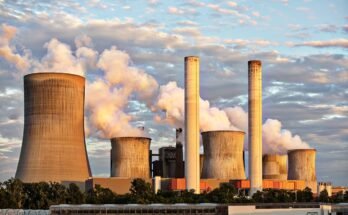The natural world refers to the incredible diversity of life and ecosystems that exist on our planet, as well as the physical processes that shape the environment around us. From the air we breathe to the oceans below us, the Earth beneath our feet to the trees that grow up into the sky and the critters who dwell there, the natural world is a complex set of webs that interconnects all of life and function. All of these elements — air, water, land, plants, animals and ecosystems — are dependent on one another, forming an interdependent ecosystem.
1. THE ATMOSPHERE: THE BREATH OF THE EARTH
The atmosphere is the layer of gases that envelops our planet, most of which is nitrogen and oxygen, with some trace amounts from other gases, including carbon dioxide and argon. It is vital for life, supplying the oxygen needed by animals and humans for respiration and the carbon dioxide needed by plants for photosynthesis. The atmosphere further shields Earth from intense solar radiation, and regulates temperatures through the greenhouse effect.
In addition, the air is responsible for the weather and the climate. Atmospheric conditions — different across regions and seasons — force winds, precipitation, and storms. The Earth’ atmosphere acts as a shunting system where energy, water and heat can be transported from one point to another around the globe, creating conditions for ecosystems to flourish, from the ice-cold Arctic tundra, to tropical rainforests.
2. Land: earth beneath our feet
From tundra to rainforest, the terrestrial systems of our planet can be incredibly diverse, with each area hosting its unique set of ecosystems and organisms. Be it the high mountains, low valleys, desert or rainforest, landforms are shaped by geological processes including tectonic plate movement, volcanic eruption and erosion.
Soil, which is formed as a result of these processes, serves as the basis for plant life. Soil, abundant in minerals and organic matter, complements plant growth by supplying them with nutrients and stability. Land also hosts a host of animal species that depend on land-based or plant-based ecological systems to thrive.
The land also has a function in the natural world involving the cycling of nutrients. Processes such as decomposition break down organic matter and return it to the soil, where it can be taken up by plants to provide energy for new growth. So the land is not only a habitat for life but a dynamic and ever-changing system that is shaped by natural forces.
3. Water: The Lifeblood of Earth
Water is the number one most important thing that sustains life and it is the very substance that makes up about 71% of the surface of the Earth. Earth’s hydrosphere includes its oceans, rivers, lakes and groundwater systems. From supporting the health of ecosystems to regulating temperatures via the heat capacity of large bodies of water, water is fundamental to life in so many ways.
Wetlands, coral reefs and freshwater lakes are incredibly diverse ecosystems that provide habitat for organisms ranging from small plankton to large whales. Water plays important roles in processes such as the water cycle, where it evaporates from the Earth’s surface, condenses into clouds and eventually falls back as rain, providing sustenance to ecosystems in its path.
Water is also vital to human life. We depend on it not just for drinking, agriculture and industry, but water also is a critical part of regulating climate on Earth. Ocean currents, for instance, contribute to heat distribution across the globe and affect weather patterns as well as life in terrestrial and aquatic contexts.
4. Plants: The Wonderful Green Heart of a Blue Planet
Plants are the basis for life on Earth. Plants use photosynthesis to turn sunlight, carbon dioxide and water into glucose, to give them the energy they need to grow and live. Plants, in turn, provide food and oxygen to nearly all other life, establishing a foundation for the entire food web.
But some of the planet’s most significant plant-based ecosystems are forests, grasslands and wetlands. And forests, in particular, are critical for stabilizing the planet’s climate. They serve as carbon sinks, take in excess carbon dioxide in its surrounding air and reduce the impact of climate change. Plants help wildlife too — they provide shelter, food and oxygen and help recycle nutrients.
While necessary to ecological processes, plants are also integrated into the aesthetic beauty of our natural world. Many take on it, albeit only a few at a time, and thus in aggregate diversity in form, color and function takes place as they add complexity to landscapes and increase biodiversity.
5. Mammals play a role as creators in the ecosystem.
Animals, from the smallest insect to the largest mammal, are an important part of the natural world. They engage with their habitats in countless ways, such as through pollinating plants, transporting seeds and converting nutrients. Herbivores, carnivores and omnivores all help maintain balance in food chains and webs, and therefore in ecosystems.
Predator-prey relationships are among the most ancient of ecosystems, and as such, have led to divergent evolution of complex behaviors and adaptations. Plant populations are kept under control by herbivores, and herbivore populations are kept under control by carnivores. These relationships prevent ecosystems from tipping too much in one direction, maintaining a thriving, diverse environment.
Among other things, animals make a contribution to the physical environment. For example, beavers create wetlands by damming rivers, and earthworms improve soil structure by burrowing through the earth. Numerous animals exert long-lasting influences over their ecosystems, playing a role in shaping the landscape and keeping it healthy.
6. Ecosystems: A Complex Community of Life
An ecosystem is a biological community of interacting organisms and their physical environment. These systems can be small, localized, or vast and global, as with the biosphere, from pond to forest. Ecosystems are far more complex than energy flows through food webs and nutrients cycling between organisms and the environment.
Ecosystems, which are not static, evolve and adapt over time, frequently as a result of natural phenomena such as fires, floods and volcanic eruptions. The ecosystems, the habitats, on the other hand, have been severely affected by human activity, which has caused habitat destruction, pollution and climate change.
Ecosystems exist in a delicate balance. If a single species dies out, the whole system can fall apart with cascading effects. All translates into the need to understand and protect ecosystems that deliver services like clean air, water, food, and medicine.
7. Natural Processes: Things that Change the World
There are various processes that govern the natural world which define and maintain the planet’s physical and biological features. For example, weather conditions shape rain, temperature, and seasonal rhythms, which influence plant and animal life. Climate, the long-term average of weather in a region, impacts ecosystems worldwide. Things like volcanic eruptions, earthquakes, and tsunamis can reshape the surface of the planet and break up the organism’s habitats but they can also create the conditions necessary for the development of new habitats and biodiversity.
The Earth’s tectonic forces pull mountains upwards in plate tectonics, land subduction in ocean cupboards, and other geological processes create various forms of oceanic and continental surfaces over millions of years. The natural processes that govern existence on Earth are interwoven; the interplay of them all shapes a world that is always in motion and constantly teeming with life.
Conclusion
Decisiones de todos, decisiones de nadie The natural world is a complex and marvelous system of interdependent elements: atmosphere, land, water, plants, animals and ecosystems. Get Free Report These components all work together in a delicate balance where things like climate, weather patterns and geological events create the world around us. It is important to understand how these factors are intertwined in order to shield the natural world and keep it for future generations. Our planet is healthier when these systems are protected, and it is our responsibility to keep our natural world beautiful and diverse



